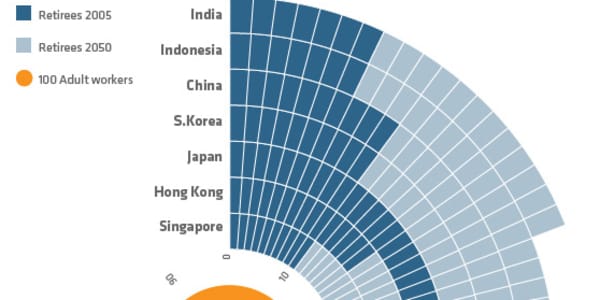Asians have traditionally cared for aging parents in the family home, but the influence of Western culture and the rising number of elderly dementia patients are driving the emergence of retirement villages and assisted living centers in the region.
Asia's population is graying; the proportion of people over the age of 65 is currently around 14 percent, according to data from the CIA Factbook, double that of 2010. By 2050, that number will nearly double again, rising to 25 percent according to U.N. estimates.
Similar demographic issues in Western countries have spurred a well-developed industry of retirement villages and assisted living centers, but they remain few and far between in Asia, where multiple generations traditionally live under one roof and live-in domestic helpers are widely affordable.
(Read more: The aging in Asia face a new decade like no other)
But as life expectancies lengthen, populations become more urbanized, living spaces get smaller and disposable incomes rise, lifestyles change.

Having seniors move in with their adult children is "over," said Chris Comer, CEO of property developer Castlewood Group, based in Singapore. "The world is becoming more and more Western."
"I'm not saying the Asian values of the family unit have been compromised. It's just not under one roof," he added.
Caring for the elderly can be a touchy subject in Singapore, an aging nation with around 8 percent of the population over the age of 65 and another 10 percent between the ages of 55 and 64.
(Read more: Singapore: A Wealthy Nation That Can't Afford to Retire)
In 2009, a Singapore minister set off a local outcry when he suggested Singaporeans consider sending elderly parents to cheaper nursing homes in Johor Bahru in Malaysia, just across the channel separating the two countries. Comer noted many Singaporeans view the Johor Bahru area, which is subject to periodic crime waves, as unsafe.
But building sizable care homes and retirement villages in land-strapped urban areas such as Singapore is simply too expensive, Comer noted. "The natural need is for the elderly to move into an affordable scene in a climate that's friendly and close to the grandkids," Comer said.
In many Asian cities, "property prices have gotten to such a level that the option to liquidate the family home is gone," as the leftover cash from buying a downsized apartment isn't enough to retire on, Comer said.
"More people will look overseas, but in close proximity" to their home countries to ensure they can afford their retirement, but still see their families, he said.
Castlewood is planning retirement villages, one near Thailand's Chiang Mai, a mountainous area known in part for its strawberry farms, and another near Phuket, near the ocean; the projects, located around two hours from Singapore by plane, are targeted toward middle-class Singaporeans.
(Read more: Exit Plan – How to Retire Abroad: Thailand)
Daughters-in-law
In China, the retirement village concept is really taking off as it becomes less common for seniors to live with their children, said Tony Wang, managing director at Belmont Village Senior Living (Hong Kong).
Daughters-in-laws, especially among the newly-weds, are increasingly reluctant to stick to tradition and live with their husbands' families, he said. "It's really about their relationships," he noted. "It's becoming common that they don't always have the same background or living habits."
In Beijing and Shanghai, about 50 percent of seniors are empty nesters, with their children living either elsewhere in the city, in other Chinese cities or even abroad, he said. About 9.4 percent of China's population is over the age of 65, with another 11 percent between 55 and 64 years old, according to the CIA Factbook.
(Read more: Megatrends: The World's Aging Population)
"There's great potential for the senior living center as a strategy. A lot of investors and insurance companies are making a lot of investments in retirement communities," Wang said, noting it's one of the few segments foreign companies are allowed to invest in.
Wang's company is developing a project with a Chinese partner, which Belmont would operate.

Dementia
The surge in the number of elderly with dementia is also driving the mainland's interest in assisted living homes. Quality dementia care is currently a "void" in China, Wang noted.
The prevalence of dementia doubles with every five-year increment in age after 65, the U.N.'s World Health Organization said in a report. It noted around 6.3 percent of people over the age of 60 in Asia have dementia.
(Read more: Countries With Aging Populations)
Caring for a loved one with Alzheimer's can be overwhelming, and many individuals and families are unprepared to deal with the consequences, financial and otherwise. In addition to memory loss, symptoms of dementia can include depression, aggression, hallucinations and difficulty controlling behavior.
"Parents who have dementia are quite a burden to the whole family," Wang said.
An assisted living setting offers better care for dementia patients, Wang said. He noted while dementia can't be reversed, the progress can be slowed by some programs, including daily organized activities.
Even younger countries seek new options.
In the Philippines, the tradition of caring for aging parents in the home isn't really changing, but career paths are, said Alma Goodwin, CEO of Life Care, an independent and assisted living center in Cebu in the Philippines.
(Read more: The World's Richest Aging Populations)
"There used to always be people in the household to care for children and parents. But now people have graduated, they have careers," leaving the parents at home with just the household help during the day, she said. Retirement villages "are places where their parents can enjoy themselves."
The development of larger scale retirement village and assisted living centers in the Philippines is just beginning, she said.
The industry's nascent state in the archipelago may be due in part to its much younger population compared with other parts of Asia; only around 4 percent of the population is over the age of 65, according to data from the CIA Factbook.




